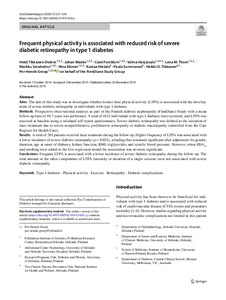Frequent physical activity is associated with reduced risk of severe diabetic retinopathy in type 1 diabetes
Valma Harjutsalo; Per-Henrik Groop; Lena M. Thorn; Markku Saraheimo; Nina Elonen; Johan Wadén; Heikki O. Tikkanen; Kustaa Hietala; Paula Summanen; the FinnDiane Study Group; Carol Forsblom; Heidi Tikkanen-Dolenc
https://urn.fi/URN:NBN:fi-fe2021042826342
Tiivistelmä
Aims
The aim of this study was to investigate whether leisure-time physical activity (LTPA) is associated with the development of severe diabetic retinopathy in individuals with type 1 diabetes.
Methods
Prospective observational analysis as part of the Finnish diabetic nephropathy (FinnDiane) Study with a mean follow-up time of 10.7 years was performed. A total of 1612 individuals with type 1 diabetes were recruited, and LTPA was assessed at baseline using a validated self-report questionnaire. Severe diabetic retinopathy was defined as the initiation of laser treatment due to severe nonproliferative, proliferative retinopathy or diabetic maculopathy (identified from the Care Register for Health Care).
Results
A total of 261 patients received laser treatment during the follow-up. Higher frequency of LTPA was associated with a lower incidence of severe diabetic retinopathy (p = 0.024), a finding that remained significant after adjustment for gender, duration, age at onset of diabetes, kidney function, BMI, triglycerides and systolic blood pressure. However, when HbA1c and smoking were added to the Cox regression model the association was no more significant.
Conclusions
Frequent LTPA is associated with a lower incidence of severe diabetic retinopathy during the follow-up. The total amount or the other components of LTPA (intensity or duration of a single session) were not associated with severe diabetic retinopathy.
Kokoelmat
- Rinnakkaistallenteet [19207]
